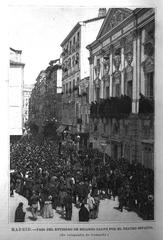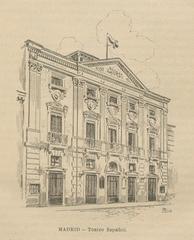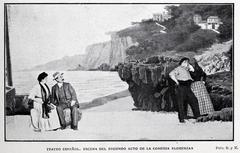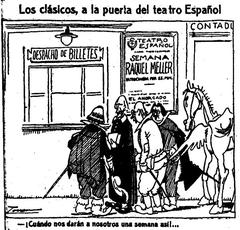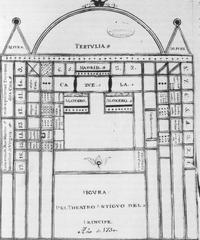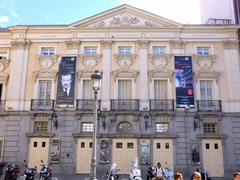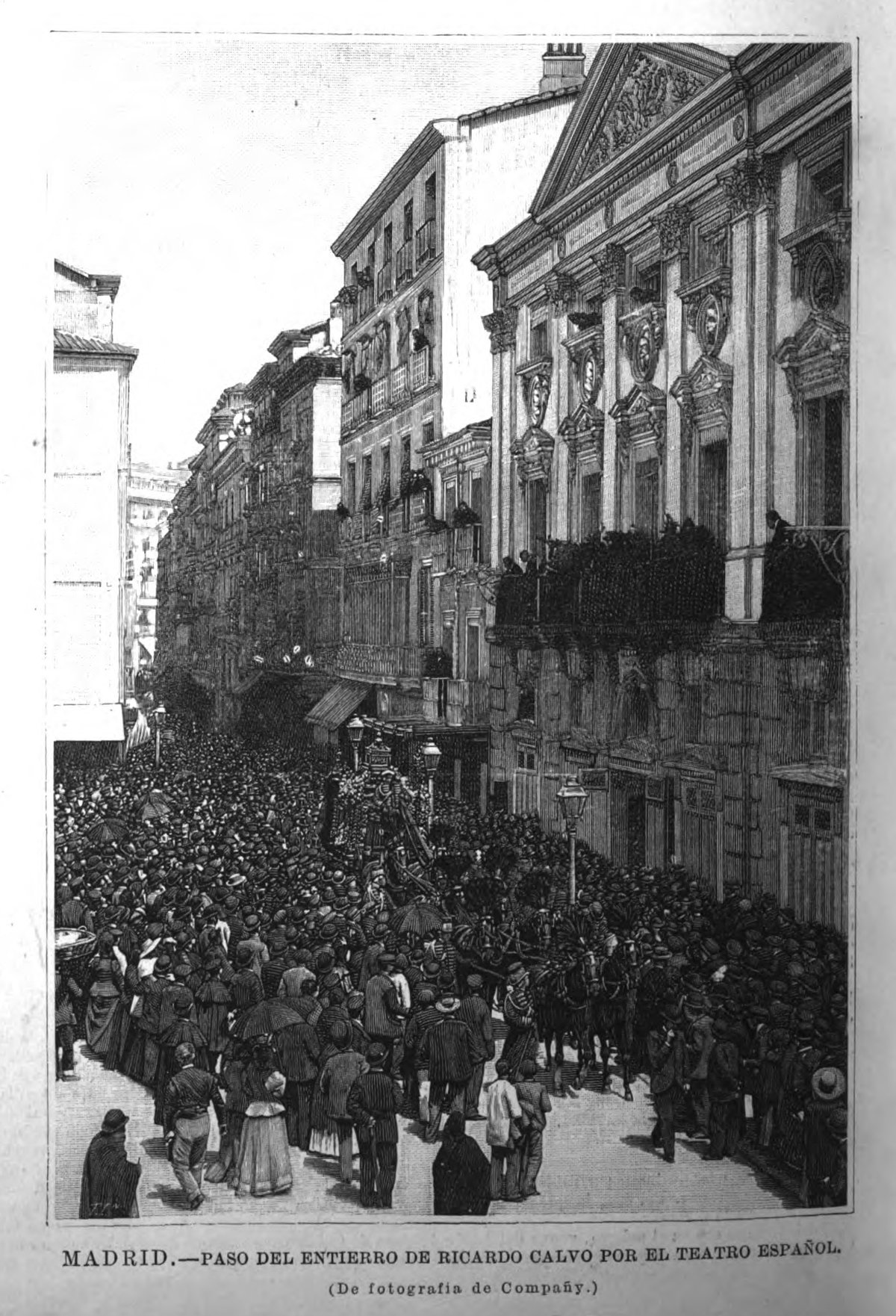
Teatro Español Madrid: Visiting Hours, Tickets, and In-Depth Historical Site Guide
Date: 14/06/2025
Introduction
Nestled in the heart of Madrid’s dynamic Barrio de las Letras, Teatro Español is a living monument to Spanish theatrical heritage and urban history. Founded in 1583 as the Corral del Príncipe, it is among the oldest continuously operating theatres in Europe. Over more than four centuries, this iconic venue has played a defining role in the evolution of Spanish drama, architecture, and cultural identity. From world premieres by luminaries like Lope de Vega and Calderón de la Barca to contemporary productions and festivals, Teatro Español’s stage has borne witness to the creative pulse of Madrid through times of triumph and turmoil (Teatro Español Exhibition; Academia.edu).
This comprehensive guide explores Teatro Español’s rich history, architectural highlights, practical visitor information (including visiting hours and ticketing), accessibility, and nearby attractions, ensuring your visit is both memorable and seamless.
Table of Contents
- Historical Overview: Origins and Cultural Significance
- Architectural Evolution and Restoration
- Visiting Teatro Español: Hours, Tickets, and Tours
- Facilities, Accessibility, and Visitor Services
- Programming, Festivals, and Special Events
- Nearby Attractions and Travel Tips
- Frequently Asked Questions (FAQ)
- Summary & Travel Tips
- References
Historical Overview: Origins and Cultural Significance
The Golden Age and Evolution
Teatro Español’s story begins in 1583, when it opened as the Corral del Príncipe, an open-air “corral de comedias” that quickly became central to Madrid’s burgeoning cultural life (Teatro Español Exhibition). During Spain’s Siglo de Oro (Golden Age), the theatre staged works by legendary playwrights including Lope de Vega, Calderón de la Barca, and Tirso de Molina—figures whose influence still resonates in Spanish literature (Cambridge History of Theatre in Spain).
As the city of Madrid rose to prominence under Philip II, Teatro Español not only reflected but also helped shape the intellectual, artistic, and social currents of the capital. The theatre played a pioneering role in the legalization of female performers and the development of new genres such as Zarzuela, marking important milestones in European theatrical history (Academia.edu).
18th–20th Century: Transformation and Resilience
By the 18th century, the original corral structure was replaced with a modern, enclosed building, mirroring shifts in theatrical style and audience expectations. Devastating fires, most notably in 1802, led to major reconstructions under architect Juan de Villanueva. The neoclassical façade and Italianate interiors that emerged from these reconstructions remain defining features of the theatre today (Fascinating Spain).
Throughout wars, political upheavals, and censorship—especially during the Spanish Civil War and Franco era—Teatro Español survived as a beacon of artistic expression, hosting landmark premieres such as Buero Vallejo’s “Historia de una escalera” in 1949 (Historia de una escalera at Teatro Español).
Architectural Evolution and Restoration
From Corral de Comedias to Neoclassical Masterpiece
The original design—a rectangular courtyard with galleries and a simple stage—was typical of Spanish Golden Age theatres (Wikipedia). In the 18th century, architects such as Juan Bautista Sacchetti and Ventura Rodríguez introduced Italianate innovations, followed by Juan de Villanueva’s elegant neoclassical redesign after the 1802 fire (esmadrid.com).
Key Architectural Features:
- Neoclassical façade: Symmetrical, with columns, pilasters, and restrained decorative elements.
- Main Hall (Sala Principal): Italian-style horseshoe layout, ornate plasterwork, and red velvet seating for 735 spectators.
- Modern amenities: 1995 expansion added rehearsal rooms, library, exhibition hall, and the intimate Margarita Xirgu Hall (2006), blending tradition with innovation (Teatro Español History).
Photographic tip: The façade facing Plaza de Santa Ana is especially striking at sunset.
Visiting Teatro Español: Hours, Tickets, and Tours
Visiting Hours
- General Opening: Tuesday–Sunday, from 10:00 AM to 6:00 PM. Performance days may have extended hours; check the official website for updates.
- Box Office: Typically opens two hours before showtime. Entry allowed 30 minutes before performances.
Ticket Information
- Pricing: €10–€40 depending on production and seat selection. Discounts for students, seniors, and groups.
- Where to Buy:
- Official website
- Box office at Calle Príncipe, 25
- Authorized vendors
- Tips: Book in advance for popular shows and festivals (e.g., Festival de Otoño (Woke Waves)).
Guided Tours
- Content: Architectural highlights, backstage access, historical insights.
- Duration: Approx. 1 hour.
- Languages: Spanish (English available with prior request).
- Booking: Advance reservations strongly recommended.
Facilities, Accessibility, and Visitor Services
- Accessibility: Ramps, elevators, adapted seating, accessible restrooms, and trained staff (esmadrid.com). Assistance dogs welcome.
- Services: Cloakroom, bar/café, restrooms, occasional gift shop, free Wi-Fi in public areas.
- Inclusive Programming: Some performances feature sign language interpretation, audio description, and English surtitles—details on the official website.
Programming, Festivals, and Special Events
Year-Round Programming: Classic Spanish plays, contemporary drama, international productions, and experimental works.
Festival Highlights:
- Festival de Otoño (October): Cutting-edge theatre and dance (Woke Waves).
- Veranos de la Villa (Summer): Outdoor and special programming (Esmadrid).
Recent/Upcoming Shows:
- Viaje hasta el límite (May–June 2025): Existential drama by Luis Martín-Santos.
- El barbero de Picasso (June–July 2025): Comedy starring Pepe Viyuela and Antonio Molero (Madrid Secreto).
Nearby Attractions and Travel Tips
- Location: Plaza de Santa Ana, Calle del Príncipe, 25, Madrid (Madrid Secreto).
- Public Transport: Metro stations Sol (Lines 1, 2, 3) and Sevilla (Line 2), plus multiple bus lines.
- Dining: Lively cafés and tapas bars in Plaza de Santa Ana (e.g., Cervecería Alemana, Café Central).
- Cultural Sites: Lope de Vega House Museum, Prado Museum, Thyssen-Bornemisza, Reina Sofía, all within walking distance (Destination Abroad).
- Best Photo Spot: Theatre’s façade at golden hour, with Plaza de Santa Ana as backdrop.
Frequently Asked Questions (FAQ)
What are Teatro Español’s visiting hours?
General hours are Tuesday–Sunday, 10:00 AM–6:00 PM. Performance days may vary; verify on the official website.
How do I buy tickets?
Purchase online, at the box office, or via authorized vendors. Advance booking advised.
Is Teatro Español accessible?
Yes. Ramps, adapted seating, elevators, and accessible restrooms are available.
Are guided tours offered?
Yes. Book in advance for insightful tours covering architecture and history.
Are performances available in English?
Some shows offer English surtitles or synopses—check event specifics.
Can I take photos during performances?
No. Photography and recording are strictly prohibited during shows.
Summary & Travel Tips
Teatro Español is more than a theatre—it’s a living chronicle of Madrid’s artistic and social evolution. With its central location near Plaza de Santa Ana, rich programming, and accessible facilities, it is an essential destination for both culture lovers and casual visitors. For a complete experience, pair your visit with a walk through the Barrio de las Letras and nearby museums. Always check the official website for current information on hours, tickets, and events, and consider booking a guided tour to deepen your appreciation for this remarkable historical site (Fascinating Spain; esmadrid.com; Madrid Secreto).
Travel Tips:
- Arrive at least 30 minutes before showtime.
- Dress code is generally smart-casual.
- Explore local cafés and museums nearby.
- Download the Audiala app for exclusive content and updates.
References
- Teatro Español Exhibition, 2023 (Teatro Español Exhibition)
- Eduardo Pérez Rasilla, El Teatro Español de Madrid: La historia 1583-2023, Academia.edu (Academia.edu)
- Cambridge History of Theatre in Spain, 2023 (Cambridge History of Theatre in Spain)
- Fascinating Spain, History of Teatro Español in Madrid (Fascinating Spain)
- esmadrid.com, Tourist Information: Teatro Español (esmadrid.com)
- Madrid Secreto, Teatro Madrid Imprescindibles, 2025 (Madrid Secreto)
- Woke Waves, Madrid 2025 Festival Guide (Woke Waves)
- Destination Abroad, Is Madrid Worth Visiting? (Destination Abroad)
